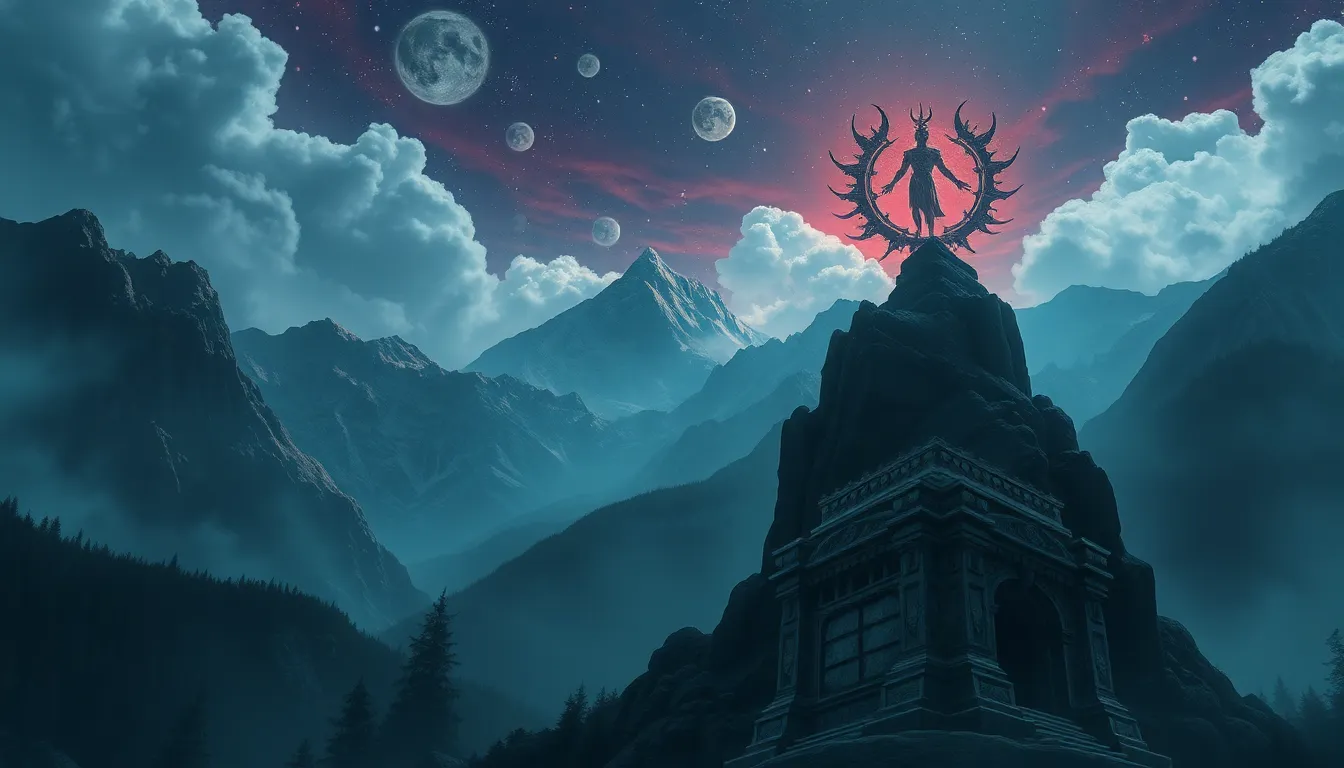The Guardian of the Mountains: Tales of Watchful Spirits
I. Introduction
Mountains have long been revered as majestic entities that inspire both awe and reverence in human cultures around the world. Throughout history, various societies have woven intricate spiritual narratives around these towering giants, often personifying them through guardian spirits. These spirits, representing the protective essence of the mountains, play a crucial role in the mythology and spirituality of diverse cultures.
This article aims to explore the tales of mountain spirits and their significance in different cultures, shedding light on how these narratives shape our understanding of nature and spirituality.
II. The Role of Nature in Spiritual Beliefs
A. Connection between mountains and the divine
Mountains are often seen as bridges between the earthly and the divine. Many cultures regard them as sacred spaces where the heavens meet the earth, making them natural sites for spiritual encounters.
B. The symbolism of mountains in different cultures
In various cultures, mountains symbolize strength, permanence, and the challenges of life. They represent a journey, both physically and spiritually, that individuals undertake in their quest for meaning. For example:
- In Hinduism, Mount Meru is considered the axis of the universe.
- In Western literature, mountains often symbolize personal trials and triumphs.
C. How natural landscapes shape spiritual narratives
The rugged terrain and awe-inspiring views of mountains create an atmosphere conducive to spiritual reflection. Natural landscapes have the power to evoke deep feelings of connection and belonging, shaping the narratives that communities tell about their surroundings.
III. Historical Perspectives on Mountain Guardians
A. Ancient civilizations and their mountain deities
From ancient Greeks who worshipped gods atop Olympus to the Norse who viewed their mountains as the domains of giants, civilizations have long attributed divine qualities to mountain ranges. These deities often served as guardians, overseeing the lands and people that resided below.
B. Folklore and legends surrounding mountain spirits
Folklore is rich with tales of mountain spirits, often depicting them as benevolent beings guiding and protecting travelers. These stories serve not only to entertain but also to instill respect for the mountains and their natural power.
C. Evolution of mountain guardian stories over time
As societies evolve, so do their stories. The guardians of the mountains have adapted to align with changing beliefs and values, showcasing the dynamic nature of folklore and spirituality.
IV. Notable Mountain Spirits from Around the World
A. The Japanese Yama-uba: Guardian of the Japanese Alps
In Japan, Yama-uba is a prominent mountain spirit often depicted as an old woman who inhabits the mountains. She serves as a guide for lost travelers and is associated with wisdom and protection.
B. The Native American Manitou: Spirit of the Mountains
Among Native American tribes, the concept of Manitou represents the spirit of the mountains. These spirits are revered as powerful forces that embody the essence of nature, often invoked in rituals for protection and guidance.
C. The Andean Apus: Sacred Mountain Spirits in South America
The Andean communities view Apus as the spirits of the mountains, revered and honored through rituals. They are believed to govern the natural elements and are central to the ecological and spiritual balance of the region.
V. Characteristics and Traits of Mountain Guardians
A. Common attributes of mountain spirits in folklore
Mountain spirits often share common characteristics, including:
- Wisdom and knowledge of the land
- Protective nature over travelers and local communities
- Connection to natural phenomena such as storms and avalanches
B. The duality of guardianship: protector and avenger
While many mountain spirits are viewed as protectors, they can also exhibit vengeful traits, punishing those who disrespect the mountains or their natural laws. This duality emphasizes the need for reverence and respect for nature.
C. The connection to natural phenomena (storms, avalanches)
Many cultures believe that mountain spirits influence weather patterns and natural events. For instance, storms may be seen as the spirits expressing their anger, while calm weather is viewed as a sign of their favor.
VI. Modern Interpretations and Representations
A. Mountain spirits in contemporary literature and art
In recent years, mountain spirits have found their way into contemporary literature and art, often representing themes of environmentalism and spiritual awakening. These representations keep ancient beliefs alive, connecting modern audiences to timeless truths.
B. The impact of globalization on traditional beliefs
Globalization has led to the blending of cultures, resulting in both challenges and opportunities for traditional beliefs about mountain spirits. While some practices may fade, others adapt, creating new narratives that resonate with a global audience.
C. How modern spirituality is adapting these ancient tales
Modern spirituality often draws from ancient tales of mountain spirits, reinventing them to fit contemporary contexts. This adaptation allows individuals to connect with their spiritual roots while addressing current environmental and societal issues.
VII. The Role of Guardians in Conservation Efforts
A. Cultural importance of mountain spirits in environmental preservation
Mountain spirits play a vital role in the cultural narratives surrounding environmental conservation. Communities often see the protection of their sacred mountains as a spiritual duty, fostering a sense of stewardship for the land.
B. Case studies of communities protecting their sacred mountains
Numerous communities worldwide have initiated conservation efforts rooted in their spiritual beliefs. Examples include:
- The protection of Mount Kinabalu in Malaysia, revered as sacred by local indigenous groups.
- The efforts of the Quechua people in Peru to preserve the Apus and their surrounding ecosystems.
C. The link between spiritual beliefs and ecological responsibility
Spiritual beliefs about mountain guardians often lead to a stronger commitment to ecological responsibility. This connection can enhance community efforts to combat environmental degradation and climate change.
VIII. Personal Encounters and Anecdotes
A. Stories from hikers and mountaineers about spirit encounters
Many hikers and mountaineers recount experiences that they interpret as encounters with mountain spirits. These stories often involve feelings of being watched over or guided, reinforcing the belief in the guardianship of the mountains.
B. Cultural rituals and practices related to mountain spirits
Cultural rituals honoring mountain spirits serve to strengthen community bonds and reinforce respect for nature. Such practices may include:
- Offerings and prayers at mountain summits
- Seasonal festivals celebrating the mountains and their spirits
C. The impact of these experiences on individuals’ worldviews
Encounters with mountain spirits often lead to profound personal transformations, altering individuals’ perspectives on nature, spirituality, and their place within the larger ecosystem.
IX. Challenges to Mountain Spirituality
A. The effects of climate change on sacred landscapes
Climate change poses a significant threat to the sacred landscapes revered by various cultures. Glaciers melting and changing ecosystems challenge the very narratives that have sustained these spiritual beliefs for generations.
B. Modern development and its impact on spiritual beliefs
Modern development practices, such as mining and tourism, often encroach upon sacred mountain spaces, leading to conflicts between economic interests and spiritual values. This tension raises questions about the future of mountain spirituality.
C. The struggle to maintain cultural heritage in a changing world
As globalization spreads, many indigenous cultures face challenges in preserving their spiritual practices and beliefs. Efforts to document and revitalize these traditions are essential to maintain cultural heritage.
X. Conclusion
Mountain spirits embody the rich tapestry of human culture, reflecting our deep connection to nature and the divine. These tales teach us invaluable lessons about respect, stewardship, and the interconnectedness of life. As we face modern challenges, they remind us of the importance of preserving not only the physical mountains but also the spiritual beliefs that honor them.
In a world where environmental concerns are increasingly urgent, acknowledging and respecting the guardians of the mountains can inspire a collective responsibility to protect these sacred spaces for future generations.



